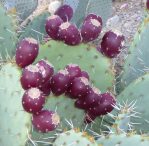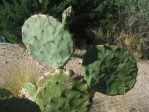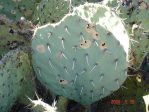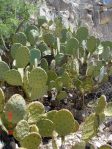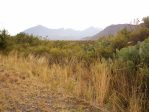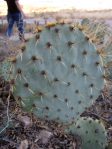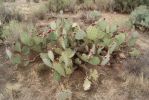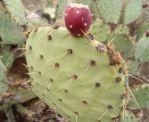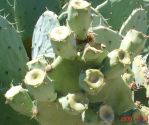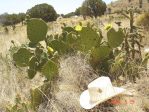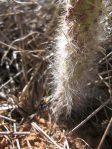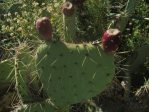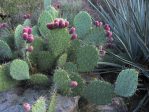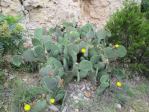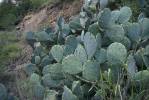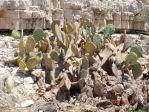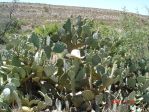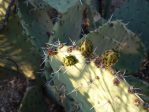
Salm-Dyck ex Pfeiffer, Enumeratio diagnostica cactearum hucusque cognitarum 156, 1837
Herbarium (as O. crinifera); Herbarium (seedling); Herbarium; Herbarium; Herbarium; Herbarium; Herbarium; Herbarium; Herbarium; Herbarium; Herbarium; Herbarium; Note: unless indicated otherwise, all herbarium specimens were submitted as O. engelmannii; Herbarium (O. dillei); Herbarium; (O. dillei); Painting
Original Description
What is Opuntia orbiculata?
Opuntia orbiculata is a large prickly pear cactus that is found over much of the West. It may be semi-upright or may sprawl along the ground. It may be nearly spineless or have multiple spines. O. dillei is a spineless variant.
See GenBank locus JF787404.1.
Details
Opuntia orbiculata is a prickly pear cactus that may reach 1 m tall, but exceptional plants may be 1 1/2 m or 2 m tall. Small plants in cold areas may be 0.5 m tall or less. Unlike O. engelmannii it is often noticeably wider than tall for a large plant. The cladodes on this prickly pear are thick and may be 12-inches wide, or they may be smaller. Cladodes are often nearly circular (orbicular), but they may be spatulate, oval, obovate, or even obdeltoid. Often, pads on this prickly pear cactus have a bluish look to them, but this is not determinative. In clement growing conditions, the plants make close-branching shrubs. In drier locations the plants may be short and spreading; they may even have trailing prostrate branches. Spines on this Opuntia are variable, but are typically white or yellow, and they may have dark bases. They can be lightly curved or straight.
Flowers are yellow with green stigmas. Fruit is egg-shaped, barrel-shaped, or even subglobose. Fruit is umbilicate, reddish-purple, and perhaps 5 cm by 6 cm. There is little or no suggestion of a narrowing at the base of fruits. Seeds are flattened, slightly angular, 3-4 mm in diameter. Seeds have a conspicuous marginal callus about 0.5 mm with a narrowly rounded margin.
O. orbiculata is tetraploid.
Other Notes
Like so many large opuntias, O. orbiculata is often misidentified as O. engelmannii because there is no slot for this cactus in guidebooks. O. orbiculata occurs in Oklahoma, Texas, New Mexico, Arizona, the desert mountains of Nevada and California, and northern Mexico. See a table comparing O. engelmannii with O. orbiculata.
Details may be lacking, but evidence supports the name, Opuntia orbiculata, for plants on this page. First, the name (O. orbiculata) is valid, but it has a confused history. Material seen by Britton and Rose was assumed by them (and I have no reason to doubt they were correct) to be the same material that was named by Salm-Dyck. It was supposedly from South America, but Britton and Rose realized that this was in error and that it had to be from North America, likely northern Mexico. Nothing similar occurs in South America.
Based on the bits of information the authors have collected as well as the description of Britton and Rose, the plants shown on this Web page are correctly identified. There really aren’t any other candidates that fit. See the discussion and description by Britton and Rose, 1919.
However, this uncertainty about the name suggests tentative use for now. If this name should be thrown out, the name, O. dillei (Griffiths, Annual Rep. Missouri Bot. Gard. 20: 82-83, 1909), was given to nearly spineless plants of the same taxon, and there is no ambiguity about that name (except for Benson’s incorrect belief that it was a hybrid).
As is typical of most Opuntia species, the plants are variable, and while many pads on many plants are nearly orbicular (circular), this is not a totally diagnostic trait. Oval, obdeltoid, obovate, and even spatulate pads are common. As with many Opuntia spp, rare pads may even have pointed ends. Pads are thick or thick appearing and fleshy seeming, more so than is the case in O. engelmannii or O. lindheimeri.
For more information, see:
Majure, L.C., Puente, R., Griffith M.P, Judd W.S., Soltis P.S and Soltis, D.E. (2012) Phylogeny of Opuntia s.s. (Cactaceae): Clade delineation, geographic origins, and reticulate evolution. American Journal of Botany, 99:847.



